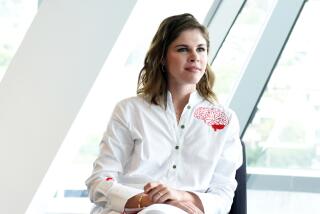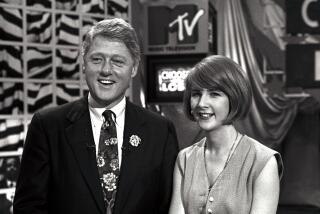Waking Up a Sleeping Giant : New TV Guide Publisher Faces Top Challenge of Career
- Share via
NEW YORK — Try telling Valerie Salembier, the recently appointed publisher of TV Guide, that she has one of the most alluring jobs in the industry and, with an ironic smile, she’ll beg to differ.
“When I was 18, I was a receptionist in the central printing department at Time Inc.,” said the 43-year-old executive at the world’s largest circulation magazine. “I thought that was the most glamorous publishing job in New York.
“It did not occur to me that it could be otherwise,” said Salembier, a baseball and boxing fan. “Why would it? Women did not have career paths then.”
Times have changed since the pre-feminist early 1960s--and so has Salembier.
Chance, rather than design, led her to publishing. But associates said it’s Salembier’s hustle that has allowed her to move through industry ranks with the forcefulness of a Sugar Ray Leonard uppercut.
Salembier was named publisher of the 16.4-million weekly circulation magazine Oct. 31, the day Australian media magnate Rupert Murdoch completed his $2.8-billion purchase of Triangle Publications, TV Guide’s parent, from Walter Annenberg.
Shunned College
Murdoch, whose News America Corp. controls the Fox Broadcasting Co. and an ever-growing stable of magazines and newspapers, said he had been wooing Salembier for some time. With the plum TV Guide slot, “We finally succeeded in attracting her,” he said.
For the former cheerleader from Teaneck, N.J., who shunned college in favor of entering the working world, her new position is “the big one,” though certainly not her first prestigious appointment.
“It was the obvious next step in my career,” said Salembier, showing the candor she is noted for during an interview in her corner office at TV Guide in Manhattan.
“I had been the No. 2 person at USA Today for five years. It was clear that I would be the publisher of a major magazine or newspaper.”
Still, she said, the TV Guide offer caught her off-guard: “I wasn’t expecting this. From a career view, this is a giant.”
And if the appointment surprised Salembier, it shocked long-entrenched department heads at TV Guide headquarters in Radnor, Pa., where, under Annenberg, there were no women beyond the ranks of middle management.
Salembier views the magazine, where advertising revenue dipped slightly in 1988 from an industry-leading $331 million last year, as “a sleeping giant.”
Her associates don’t doubt that she can wake it up.
“Valerie is simply the best ad salesperson I ever met,” said John B. Evans, president of Murdoch Magazines, the division of News America to which TV Guide now belongs. “We hired her because she has the pragmatism to be able to put the magazine to bed every week and the vision to evolve it in the future.”
How Salembier will alter TV Guide, viewed by industry observers as uninspired despite its enormous success, remains to be seen.
But clearly Salembier and her bosses, who have already made some key personnel changes at the television-listings magazine, aren’t content to let it stay the same.
“I think it’s time for some careful, creative, well-thought-out change,” said Salembier, who, like many people of her generation, remembers the weekly TV Guide laying beside her family’s television set as she was growing up. “It could be a format change. Perhaps (the infusion of) just a little more fun. After all, this is an entertainment industry first and foremost.”
Salembier’s initial concern, though, “is getting out and meeting the advertisers.”
“It sounds sophomoric, but that’s been my strategy everywhere I’ve been,” she said.
Most recently senior vice president of advertising at USA Today, where annual advertising revenue nearly quadrupled to $150 million during her tenure, Salembier has sales experience dating to 1970, when she moved up from a merchandise copywriter to become Newsweek’s first woman sales representative.
Her promotion was fostered by an argument between Katharine Graham, chairwoman of Newsweek’s parent, Washington Post Co., and Gibson McCabe, who was then president of Newsweek, over the lack of saleswomen on the magazine’s staff.
“I was the result of Kay Graham throwing a leaded crystal ashtray at McCabe,” Salembier said.
She left Newsweek in 1976 to join Ms. magazine as advertising director and rose to associate publisher during a six-year stay.
She is credited with making believers out of national advertising account executives who had previously scoffed at Ms., believing that the publication was too far out of the mainstream.
Hardest Sell Ever
“Valerie really persuaded auto makers in Detroit to advertise with us,” said Patricia Carbine, the former publisher of Ms. “In 1972, when we first started Ms., our sales calls to Detroit were the object of great unbelief. But Detroit was persuaded by her seriousness and relentlessness to begin to take a look at our market.”
Salembier described Ms. magazine “as the hardest sell ever.”
“You had an advertising community asking, ‘Why would I want to advertise my product in this magazine? Women like you aren’t Ms. readers,’ ” she said. “I had to convince them that I am the Ms. reader and I wear nail polish and lipstick and have clean hair.”
Her time at Ms. also heralded a turning point in her career.
“At Newsweek, I wasn’t the rep calling on the Dewars-type accounts,” she said. But at Ms. she and other women suddenly were handed “enormous visibility in the sales and marketing arena.”
“It was very heady stuff,” Salembier said. “I started trusting myself and my ability.”
Between her positions at Ms. and USA Today, Salembier also did short stints as the publisher of Inside Sports and the vice president of student publications for 1330 Corp., which is now Whittle Communications.
In 1973, she earned a bachelor’s degree in liberal arts from the College of New Rochelle in suburban Westchester County after attending night courses there and at Fordham University in Manhattan.
“It was not a traditional education,” said Salembier, who, while attending Fordham, would catch a late-night train to Philadelphia, where she was living at the time, and return to New York early the next morning to be in her office. “But I was ready for it in a way that I was not at the age of 17.”
Relaxed and self-assured, Salembier--a New York Mets fan and season-ticket holder for Thursday night boxing bouts at Madison Square Garden--remains unaffected by her success, friends and colleagues said.
“She’s confident with where she is and who she is so she doesn’t have to have an attitude about it,” said close friend Wendi Rogers, 27, a makeup artist and aspiring pop singer who also is Salembier’s second cousin.
“She is extraordinarily well-rounded,” said Carbine, whom Salembier described as her mentor. “She’s passionate about her work and, unlike most people who work as hard as she does, she manages to be equally as passionate about a diverse range of other interests.”
Weekends might find her driving her Nissan Pathfinder truck to a fly-fishing hole or, if she stays around her Manhattan apartment, putting her considerable Chinese cooking skills to work.
Salembier, who is divorced and has no children, said she is dating for the first time in her life.
For now, Salembier considers her TV Guide appointment as “sort of like a new marriage.”
“It’s going to take awhile to get used to it,” Salembier said. “But it’s a huge opportunity.”
And that is something Valerie Salembier has always embraced.
More to Read
The biggest entertainment stories
Get our big stories about Hollywood, film, television, music, arts, culture and more right in your inbox as soon as they publish.
You may occasionally receive promotional content from the Los Angeles Times.










